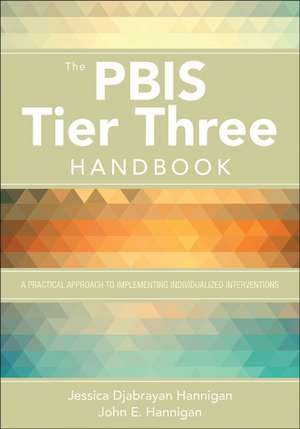The PBIS Tier Three Handbook: A Practical Guide to Implementing Individualized Interventions
Autor Jessica Hannigan, John E. Hanniganen Limba Engleză Paperback – 3 sep 2018
Preț: 245.61 lei
Nou
Puncte Express: 368
Preț estimativ în valută:
47.00€ • 48.77$ • 39.29£
47.00€ • 48.77$ • 39.29£
Carte tipărită la comandă
Livrare economică 15-29 martie
Preluare comenzi: 021 569.72.76
Specificații
ISBN-13: 9781544301174
ISBN-10: 1544301170
Pagini: 144
Dimensiuni: 178 x 254 x 10 mm
Greutate: 0.32 kg
Ediția:First Edition
Editura: SAGE Publications
Colecția Corwin
Locul publicării:Thousand Oaks, United States
ISBN-10: 1544301170
Pagini: 144
Dimensiuni: 178 x 254 x 10 mm
Greutate: 0.32 kg
Ediția:First Edition
Editura: SAGE Publications
Colecția Corwin
Locul publicării:Thousand Oaks, United States
Recenzii
This series of books are a must-have for schools looking to strengthen their PBIS framework. They provide the essential tools and innovative ideas for building a positive school culture with strong levels of support for ALL students.
This handbook is user friendly with templates that are well-organized and ready to go. Administrators can spend time personalizing them rather than starting from scratch and missing key components. Highly recommend purchasing this handbook for your entire administrative team.
As educators, we often speak about giving students second chances; The PBIS Tier 3 Handbook puts these words into action.
The PBIS Tier Three Handbook: A Practice Guide to Implementing Individualized Interventions documents a relatively small community of special needs students whose requirement for 'tier three' support holds a major impact on others in the classroom. It offers teachers an approach to the concept and implementation of individualized interventions for this group, showing how to identify such needs, how to blend them into special needs groups and general classroom structures and objectives, and how to take actions to establish a Tier 3 environment. Many pages assume a workbook-style format with fill-in questionnaires and notes teachers can make directly into the book, while others outline red flags, typical assessment routines, and the elements and strategies of a Tier 3 environment. No educator's collection should be without this specific, important manual to classroom interventions and success.
This handbook is user friendly with templates that are well-organized and ready to go. Administrators can spend time personalizing them rather than starting from scratch and missing key components. Highly recommend purchasing this handbook for your entire administrative team.
As educators, we often speak about giving students second chances; The PBIS Tier 3 Handbook puts these words into action.
The PBIS Tier Three Handbook: A Practice Guide to Implementing Individualized Interventions documents a relatively small community of special needs students whose requirement for 'tier three' support holds a major impact on others in the classroom. It offers teachers an approach to the concept and implementation of individualized interventions for this group, showing how to identify such needs, how to blend them into special needs groups and general classroom structures and objectives, and how to take actions to establish a Tier 3 environment. Many pages assume a workbook-style format with fill-in questionnaires and notes teachers can make directly into the book, while others outline red flags, typical assessment routines, and the elements and strategies of a Tier 3 environment. No educator's collection should be without this specific, important manual to classroom interventions and success.
Cuprins
Preface
About the Authors
Before You Begin: How to Use The PBIS Tier Three Handbook
Part I: Overview
1. The PBIS Champion Model
2. The What and Why of a PBIS Tier 3 System
Part II: The PBIS Tier Three Handbook
3. Getting Started With Category A—Tier 3 Markers
4. Getting Started With Category B—Tier 3 Characteristics
5. Getting Started With Category C—Tier 3 Academic and Behavior SMART Goals and the Work of the PBIS Tier 3 Sub-Team
6. Tier 3 Lessons Learned, Case Studies, and Bringing It All Together
Part III: What Next?
7. Next Steps and Tips for Success
Index
About the Authors
Before You Begin: How to Use The PBIS Tier Three Handbook
Part I: Overview
1. The PBIS Champion Model
2. The What and Why of a PBIS Tier 3 System
Part II: The PBIS Tier Three Handbook
3. Getting Started With Category A—Tier 3 Markers
4. Getting Started With Category B—Tier 3 Characteristics
5. Getting Started With Category C—Tier 3 Academic and Behavior SMART Goals and the Work of the PBIS Tier 3 Sub-Team
6. Tier 3 Lessons Learned, Case Studies, and Bringing It All Together
Part III: What Next?
7. Next Steps and Tips for Success
Index
Notă biografică
Dr. Jessica Djabrayan Hanniganis an Assistant Professor in the Educational Leadership Department at California State University, Fresno. She works with schools and districts throughout the nation on designing and implementing effective behavior systems. Dr. Hannigan has a background in special education and student support services as well as experience with district level administration and higher education research. Jessica has developed inclusive research based best practices around systematic implementation of behavior initiatives. Dr. Hannigan is the co-author of multiple educational books such as The PBIS Tier One Handbook, The PBIS Tier Two Handbook, The PBIS Tier Three Handbook, Don¿t Suspend Me! An Alternative Discipline Toolkit, Building Behavior, The MTSS Start-Up Guide, and Behavior Solutions. She has received multiple recognitions for her work, including being named California Outstanding School Psychologist of the Year, Administrator of the Year, Outstanding Faculty Publications and Service Award recipient. She was also recognized by the California Legislature Assembly for her work in social justice and equity. In 2017, Dr. Hannigan was awarded the inaugural Association of California School Administrators Exemplary Woman in Education Award for her persistent work around equity in schools.
Descriere
This step-by-step guide helps identify students who need Tier Three support, create procedures and protocols, and develop individualized interventions.
